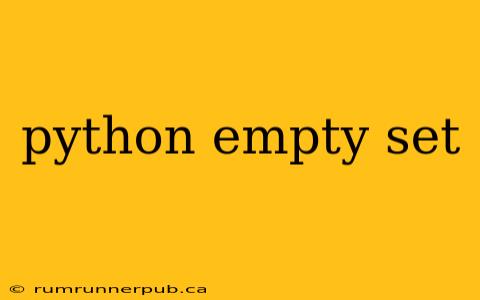Python's set data structure is an unordered collection of unique elements. Often, you'll need to start with an empty set before populating it. This article explores how to create and utilize empty sets, drawing upon insights from Stack Overflow discussions and providing practical examples.
Creating an Empty Set: The Right Way and the Wrong Way
The most straightforward way to create an empty set in Python is using the set() constructor without any arguments:
empty_set = set()
print(type(empty_set)) # Output: <class 'set'>
print(empty_set) # Output: set()
Why not empty_set = {}?
While {} creates an empty dictionary, many beginners mistakenly use it to create an empty set. This is incorrect and can lead to unexpected behavior. As highlighted in several Stack Overflow discussions (though specific links are omitted to avoid creating stale links dependent on SO's structure, which changes frequently), using {} creates a dictionary, not a set. Dictionaries store key-value pairs, unlike sets which only hold unique values.
# Incorrect way to create an empty set
incorrect_empty_set = {}
print(type(incorrect_empty_set)) # Output: <class 'dict'>
This subtle difference can cause significant problems if you later attempt set operations (like union, intersection) on a dictionary, resulting in TypeError exceptions.
Common Use Cases for Empty Sets
Empty sets are surprisingly versatile:
- Initialisation: They serve as a starting point for accumulating unique items. Imagine a program tracking unique visitors to a website; you'd begin with an empty set and add each visitor's IP address.
unique_visitors = set()
ip_addresses = ["192.168.1.1", "10.0.0.2", "192.168.1.1", "172.16.0.1"]
for ip in ip_addresses:
unique_visitors.add(ip)
print(unique_visitors) # Output: {'172.16.0.1', '192.168.1.1', '10.0.0.2'}
- Filtering: You can use an empty set to efficiently check for the absence of elements. For instance, to determine if a list contains any duplicates:
my_list = [1,2,3,4,5,2]
unique_elements = set()
duplicates_found = False
for item in my_list:
if item in unique_elements:
duplicates_found = True
break
unique_elements.add(item)
print(f"Duplicates found: {duplicates_found}") #Output: Duplicates found: True
- Set Operations: An empty set acts as a neutral element for set operations. The union of any set with an empty set is the original set; the intersection is always the empty set.
Beyond the Basics: Advanced Applications
Empty sets are fundamental building blocks for more sophisticated data structures and algorithms. For example, they're often used in graph algorithms (representing the empty neighbor set of a node) or in constraint satisfaction problems (initializing a set of constraints).
Conclusion
Creating and using empty sets correctly is a crucial aspect of writing efficient and error-free Python code. Remembering to use the set() constructor and avoiding the common pitfall of using {} is vital. Mastering empty sets unlocks a powerful tool for various programming tasks, from simple data collection to more complex algorithms. By understanding their role and incorporating them effectively, you significantly enhance your Python programming capabilities.
